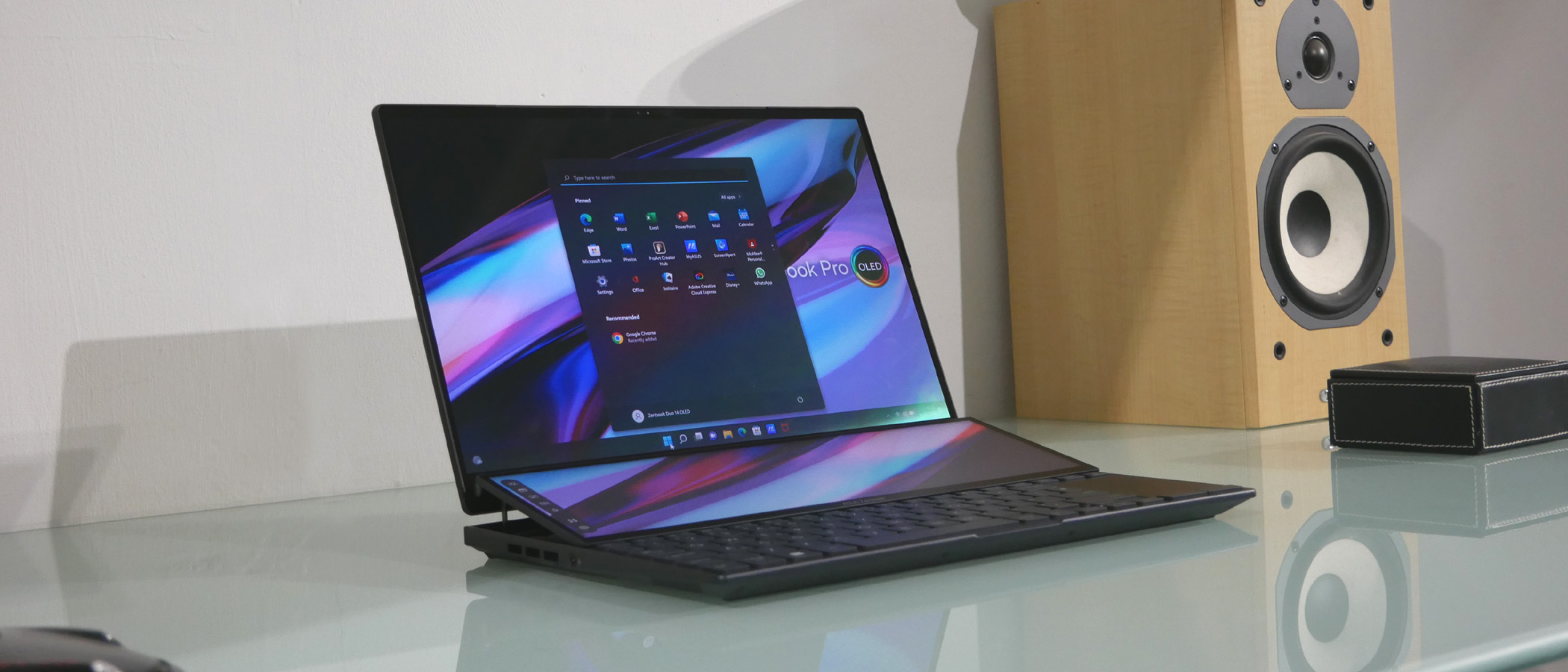Our Verdict
Stellar build quality, two gorgeous screens and some seriously powerful components. The Asus Zenbook Pro 14 Duo OLED has all of that and more. It’s a stupendous machine. The 120Hz OLED panel is a real highlight, but excellent connectivity and great sound quality only add to the appeal. On the downside, the dual-screen design makes for challenging keyboard and trackpad ergonomics, while the life is disappointing. It’s not for everyone, the Asus Zenbook Pro 14 Duo OLED. But for certain workflows, it’s a genuine delight.
For
- Fabulous screen tech
- Excellent connectivity
- Gorgeous build quality
Against
- Unusual ergonomics
- Mediocre battery life
- Slightly limited performance
Why you can trust Creative Bloq
Dual screens, OLED technology, gorgeous engineering, top-spec components and just a hint of existential angst? That’ll be the hot new-for-2022 Asus Zenbook Pro 14 Duo OLED UX8402. What an extraordinary machine.
The main attraction is the combination of a stunning 14.5-inch OLED display running at 120Hz and capable of an incredible 100 percent coverage of the DCI-P3 gamut with a full-width secondary screen. Both panels have touch input and inking support.
CPU: Intel Core i9-12900H (14-core)
Graphics: Intel Iris Xe, Nvidia RTX 3050 Ti 4GB
RAM: 32GB DDR5
Screen: 14.5-inch 2880 x 1800 120Hz OLED, 12.7-inch 2880 x 864 IPS
Touch input: Capacitive multi-touch with stylus
Storage: 1TB NVMe SSD
Ports: 2x USB Type-C with Thunderbolt 4, 1 x USB-A 3.2, SD card, HDMI 2.1, 3.5mm audio jack, SD card reader
Connectivity: Wi-Fi 6E, Bluetooth 5.2
Battery: 76Wh
Camera: 720P webcam
Weight: 1.7 Kg (3.75 lbs)
Size: 32.35 x 22.47 x 1.96cm (2.74" x 8.85" x 0.77"); W x D x H
To that you can add Intel’s latest 12th-Gen CPU in monster 14-core spec, a discrete Nvidia GPU, a stupid-fast SSD and a hunk of fast DDR5 memory. Oh, and great connectivity thanks to a couple of Thunderbolt 4-spec USB-C ports, WiFi 6E and an SD Express 7.0 card reader.
It’s wrapped up in a high-quality chassis, all in characteristically premium Asus style. If that sounds like a spectacular package, it is. And yet there are a few question marks. The dual-screen setup dictates unusual keyboard and trackpad ergonomics, just for starters. Then there’s the impact of all that display tech on battery life.
Of course, none of this comes cheap. So, the core conundrum is whether the upsides of the extraordinary screen tech and elite engineering outweigh the cost and complexity. In short, what does that second screen add to the computing experience? Time to find out.
Asus Zenbook Pro 14 Duo OLED (2022) review: features
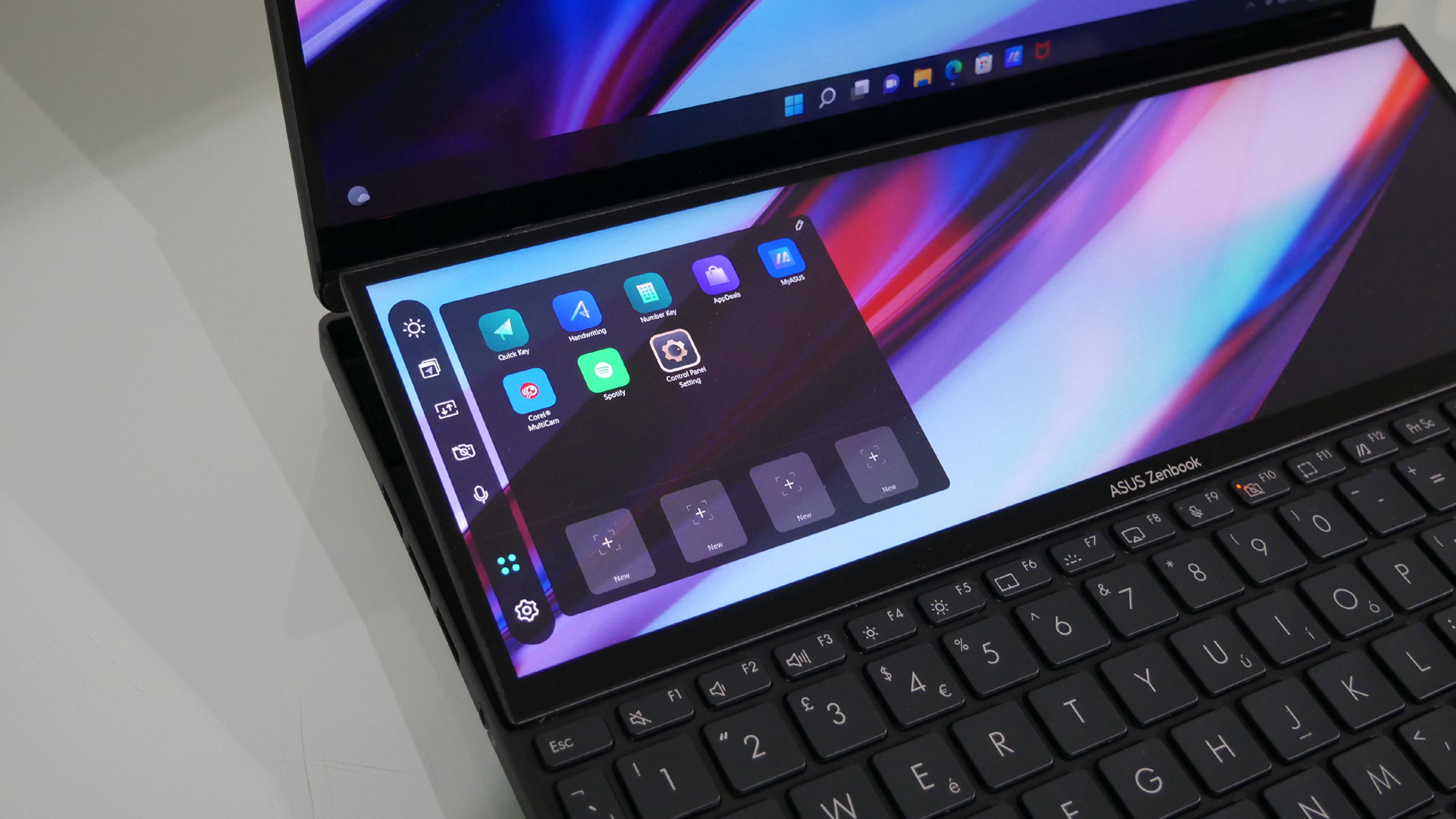
No question it’s the two screens that define this laptop. The primary display is a 14.5-inch and 16:10 aspect ratio OLED panel with 2,880 by 1,800 pixels. Thanks to that OLED tech, it’s rated at a remarkable 0.2ms for response. Conventional LCD panels are considered ultra-quick when they can hit 1ms.
Asus also says it’s good for 550 nits of brightness and the refresh is 120Hz. Impressive? Definitely, but from a content creation perspective, the incredible colour coverage, HDR capabilities and panel certifications will be even more important. The 100 percent coverage of the DCI-P3 digital cinema gamut is outstanding, while the VESA DisplayHDR True Black 500 and Pantone certifications add up to a very strong overall proposition from a portable display perspective.
Daily design news, reviews, how-tos and more, as picked by the editors.
Of course, that’s just the primary screen. Below it is a 12.7-inch panel with the same actual width and horizontal resolution of 2,880 pixels However, it’s much shallower at 864 vertical pixels and the technology is conventional IPS LCD not OLED. That said, both screens are fully touch enabled and support stylus input and are compatible with Microsoft Pen Protocol active styluses. Asus actually includes one of its own Asus Pen 2.0 styluses. It’s good for a claimed 4,096 levels of pressure sensitivity and charges via USB-C.
Beyond the exotic display tech, Asus has loaded this portable up with bleeding-edge hardware. Intel’s latest Core i9-12900H monster with six Alder Lake performance cores and eight efficiency cores covers the main processing duties, backed up here by 32GB of DDR5 memory and a 1TB Samsung SSD in super-speedy PCIe Gen 4 spec. That’s all about as good as laptop PC hardware currently gets.
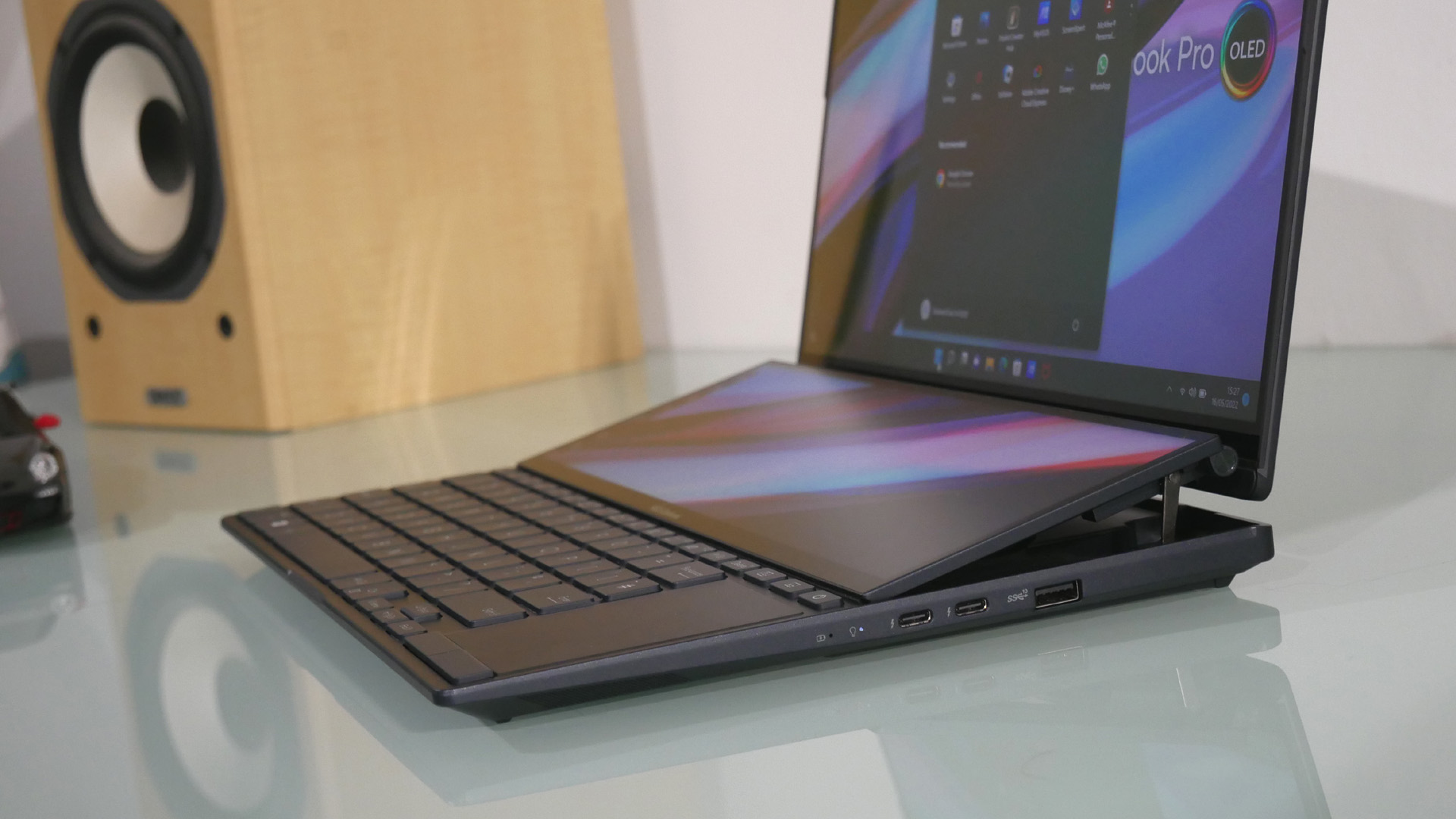
The one exception is the Nvidia GeForce RTX 3050 Ti graphics. That’s more of a low to mid-range GPU than a really high performance chip. For gaming, it’s pretty basic. But for image and video-editing workflows that benefit from GPU acceleration, it will make a tangible difference over integrated graphics.
For connectivity, the dual USB-C ports have full 40Gbps Thunderbolt 4 support for the fastest possible external storage, which is handy given the 1TB SSD isn’t all that capacious for video editing. On the photography side, SD Express 7.0 card reader is likewise as quick as that format gets, while the USB-A port is again in maximum-speed 3.2 spec.
The dual screens absolutely define this laptop
It’s a similar story with the HDMI 2.1 port that supports full 4K output at 120Hz, plus the up-to-the-minute WiFi 6E and Bluetooth 5.2. In short, it is all the latest and fastest available technology. There are absolutely no oversights.
Rounding out the key features are a full speaker system by Harmon Kardon and a beefy (for a 14-inch laptop) 76Wh battery which will have plenty to do keeping those two screens going. Less exciting is the 720p webcam, though at least it’ll cover off some basic online conferencing.
Asus ROG Strix Scar 15 (2022) review: design
Make no mistake, this is a beautifully engineered laptop. The build quality is stupendous. It looks and feels seriously expensive. Question is, do those dual screens make ergonomic sense?
First up, that secondary screen is obviously quite shallow. So, it’s not hugely useful for normal web browsing. It’s not really comfortable for an email client or webmail either, you just can’t see enough. On the other hand, you might load up, say Spotify and whatever collaboration tool you use for work and have that running beneath your main workflow on the primary display. To that end, Asus’s software tools for managing windows both on the secondary display and when it comes to quickly shifting applications and windows between displays works really well.
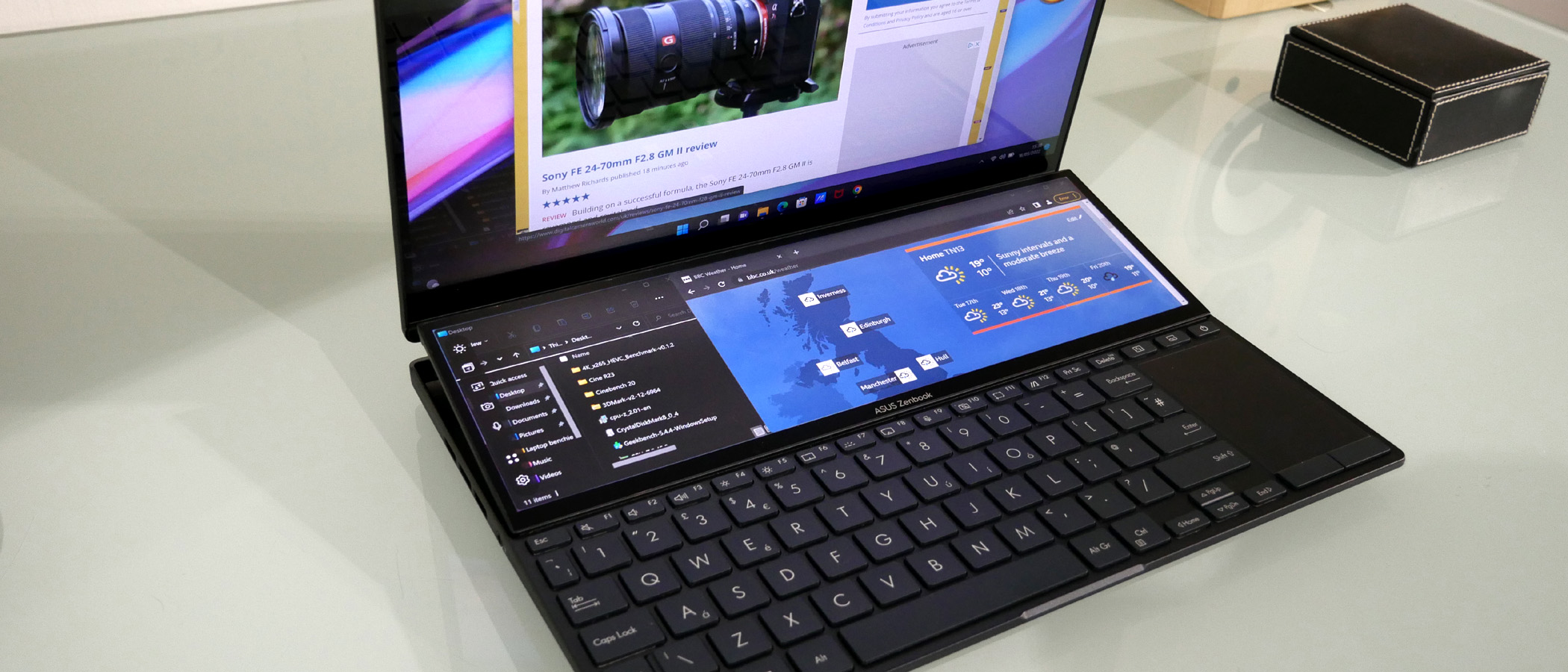
But the whole thing hangs together best when the secondary display is used for toolbars, timelines and other control panels in content creation apps like video editing. You’ve then got the entire 14.5-inch OLED panel to view the content. It’s also worth noting that the 120Hz refresh of the main screen helps keep latency to an absolute minimum when using a stylus for input.
What’s more, the dual-screen engineering isn’t just slick, it’s clever too. The bottom screen hinges up as you open the laptop, not only providing better viewing angles, but also creating an opening for airflow to keep those powerful chips cool.
However, there are downsides. For starters, this is no featherweight laptop at 1.7kg. Perhaps more importantly, the dual-screen design squeezes the keyboard right to the bottom of the chassis and crams the trackpad into the bottom right. In terms of typing, it definitely takes some getting used to, even if the keyboard bed is super solid and the key action nice and precise. The trackpad is also much smaller than is the fashion these days, with an unusual portrait aspect ratio.
Asus Zenbook Pro 14 Duo OLED (2022) review: price
Starting at $1,999 and roughly the same figure in the UK, the Asus Zenbook Pro 14 Duo OLED isn’t exactly a bargain. But then, all that hardware was never, ever going to come cheap. Our review configuration ramps that up significantly thanks to the top-spec Intel CPU and 32GB RAM, at which point you’ll be over $2,500 or £2,500. Of course, no laptop with similar components is going to be terribly affordable, even with a single screen. Factor in the exceptional screen tech and the value proposition isn’t actually too bad.
We’d only highlight that if your main attraction is the 14-inch OLED panel, if you shop around there is still availability on the previous-gen 14-inch single-screen Asus Zenbook with 11th Gen Intel CPUs and prices starting as low as $1,000 or £1,000. The previous generation Zenbook Duo 14 with a lower resolution IPS screen can also be had for similar cash.
Asus Zenbook Pro 14 Duo OLED (2022) review: performance
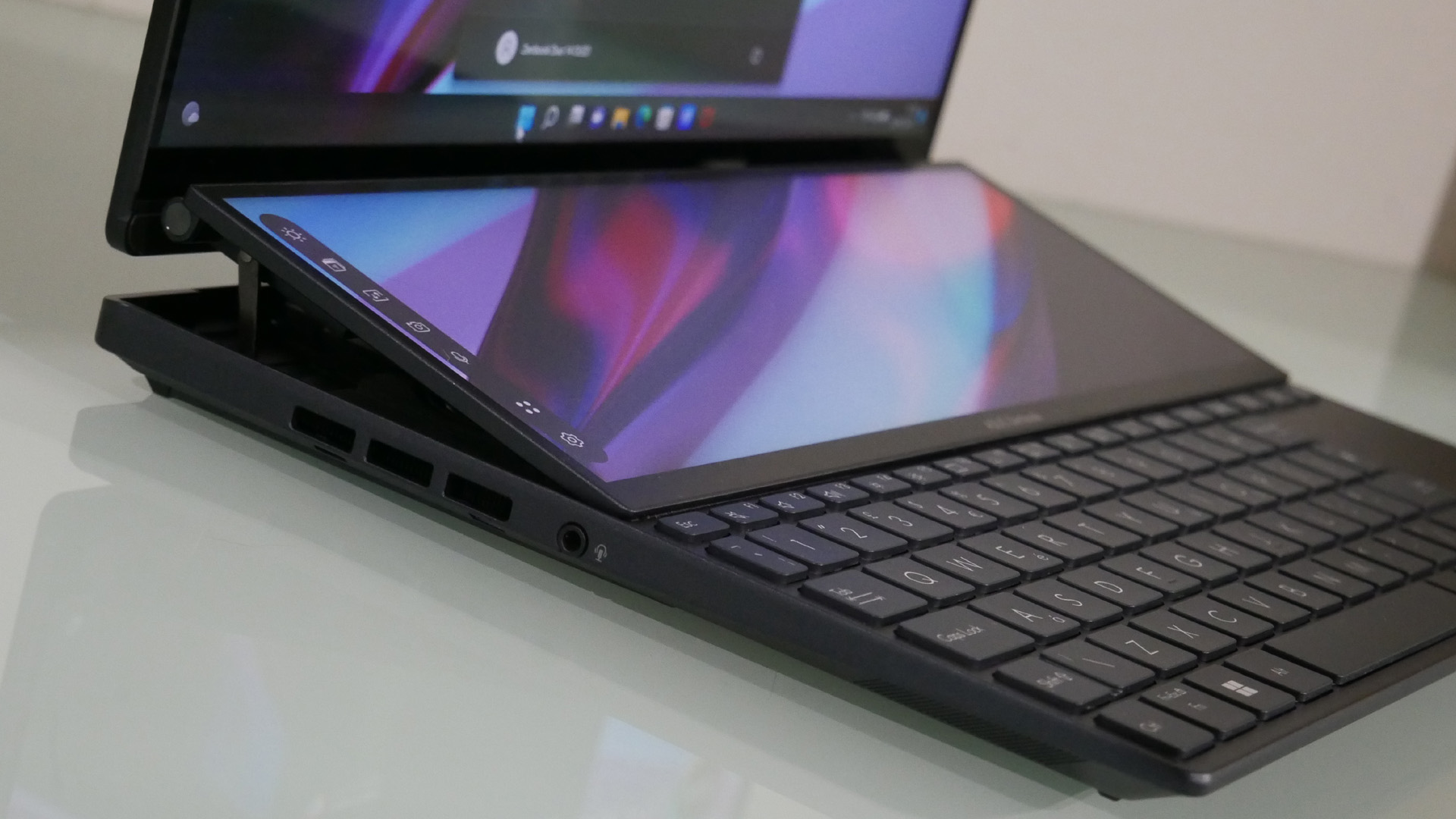
3DMark: Night Raid: 38,730; Fire Strike: 12,718; Time Spy: 5,893
Cinebench R20 Multi-core: 5,558 points
GeekBench 5: 1,713 (single-core); 11,930 (multi-core)
PCMark 10 (Home Test): 6,505 points
Battery Life (1080p movie test): 6 hours and 54 minutes
Total War: Three Kingdoms: (1080p, Ultra): 44 fps; (1080p, Low): 170 fps
Metro Exodus: (1080p, Ultra): 42 fps; (1080p, Low): 133 fps
Crystal Disk Mark: Read 6,390MB/s, write 5,150MB/s, 4K read 75MB/s, 4K write 150MB/s
4K x265 (HEVC) encode: 9.7fps
The Asus Zenbook Pro 14 Duo OLED’s specifications raise some serious expectations. In practice, it can’t quite deliver. To be sure, this is a very powerful laptop, especially for a 14-inch model. But the Intel Core i9-12900H isn’t delivering its best in this system.
In our testing using the standard fan profile, the chip clocked down to 2.9GHz under heavy load. Ramping the fans up to maximum increases that to around 3.2GHz, but with that comes some unpleasantly intrusive noise.
For context, those clockspeeds are at least 10 percent slower than you’ll see in larger notebooks with the same CPU. Indeed, we found that in 4K video encoding the performance gap to the larger laptops with the 12900H processor is more like 20 percent. Which still means you’re getting a lot of punch. But inevitably not quite as much as you would in a larger laptop.
That said, thanks to a PCIe Gen 4 spec Samsung SSD and that beefy 32GB of RAM, overall system performance is super strong. The Zenbook not only cranks out an impressive result in PCMark 10, arguably more important is how it handles workloads like large batches of RAW image files with filters applied with such aplomb. In real world terms, you’ll only get obviously slicker performance in video editing terms from Apple’s latest MacBooks and even then only if you are using workflows that fully leverage Apple’s hardware encode and decode engines.
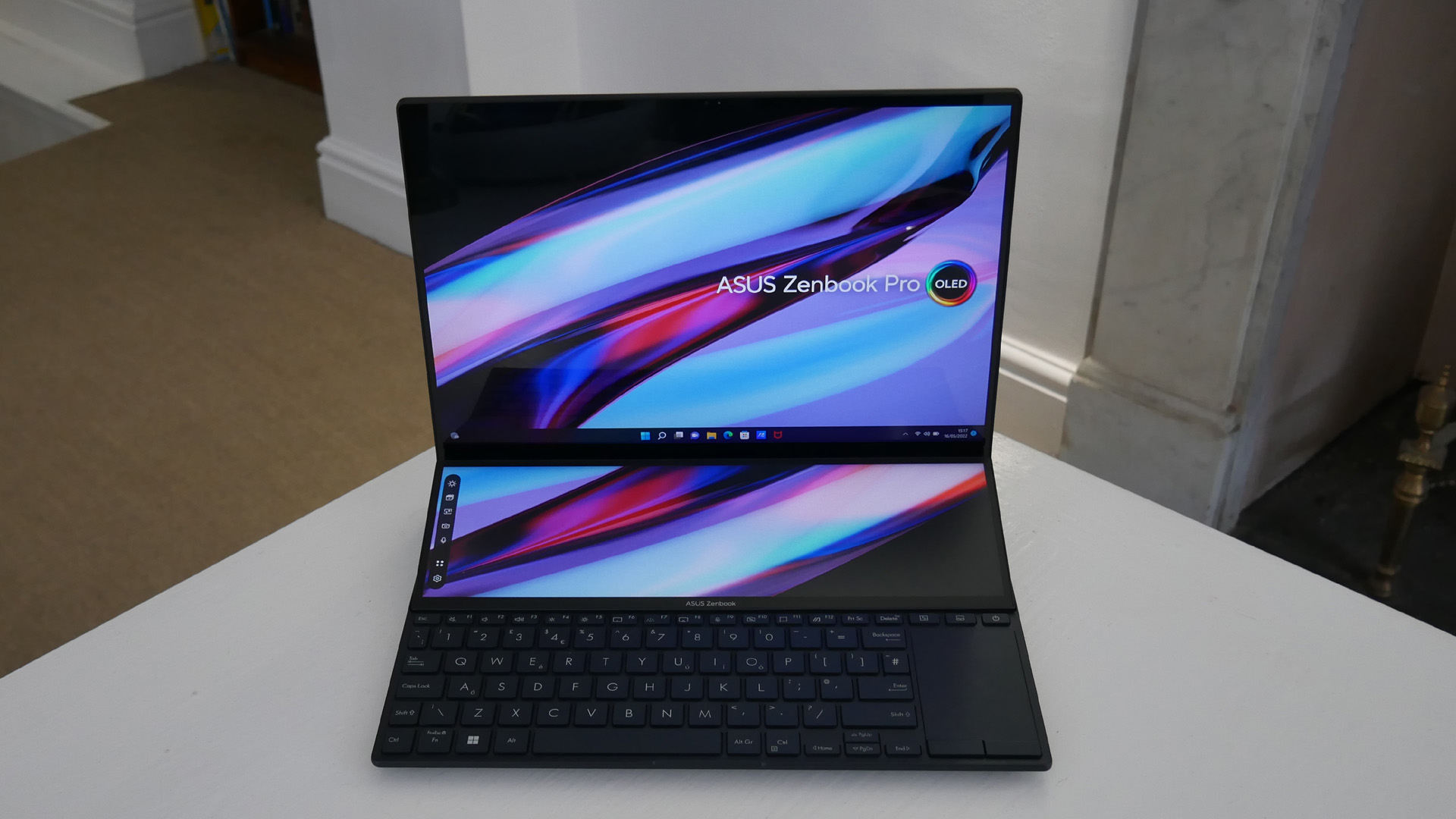




As for the performance of those two screens, the main OLED is gorgeous, with epic contrast, fabulous response and that buttery 120Hz refresh. It’s a real delight. The only slight flaw is the touchscreen’s digitiser which you can just see. It’s not a huge distraction, but it does very slightly detract from the panel’s clarity. The smaller IPS panel can’t match the bigger OLED for punch and contrast. It also has a slightly different surface texture. But, again, it’s not a major distraction.
Visuals aside, the Harmon Kardon speakers are a very clear step up over most PC laptop speakers with excellent dynamic range and some real warmth to the soundstage. You’d have to go to an Apple MacBook Pro to get significantly better sound - and that is a complement.
On the other hand, we are significantly less impressed by the battery life. You’d think disabling the secondary screen would give this portable its best shot. But even then and with the primary OLED panel running at half brightness, it can only manage just under seven hours of 1080p video playback. Suffice to say that enabling both screens and using more demanding apps will see that number dwindle dramatically.
Should you buy the Asus Zenbook Pro 14 Duo OLED (2022)?
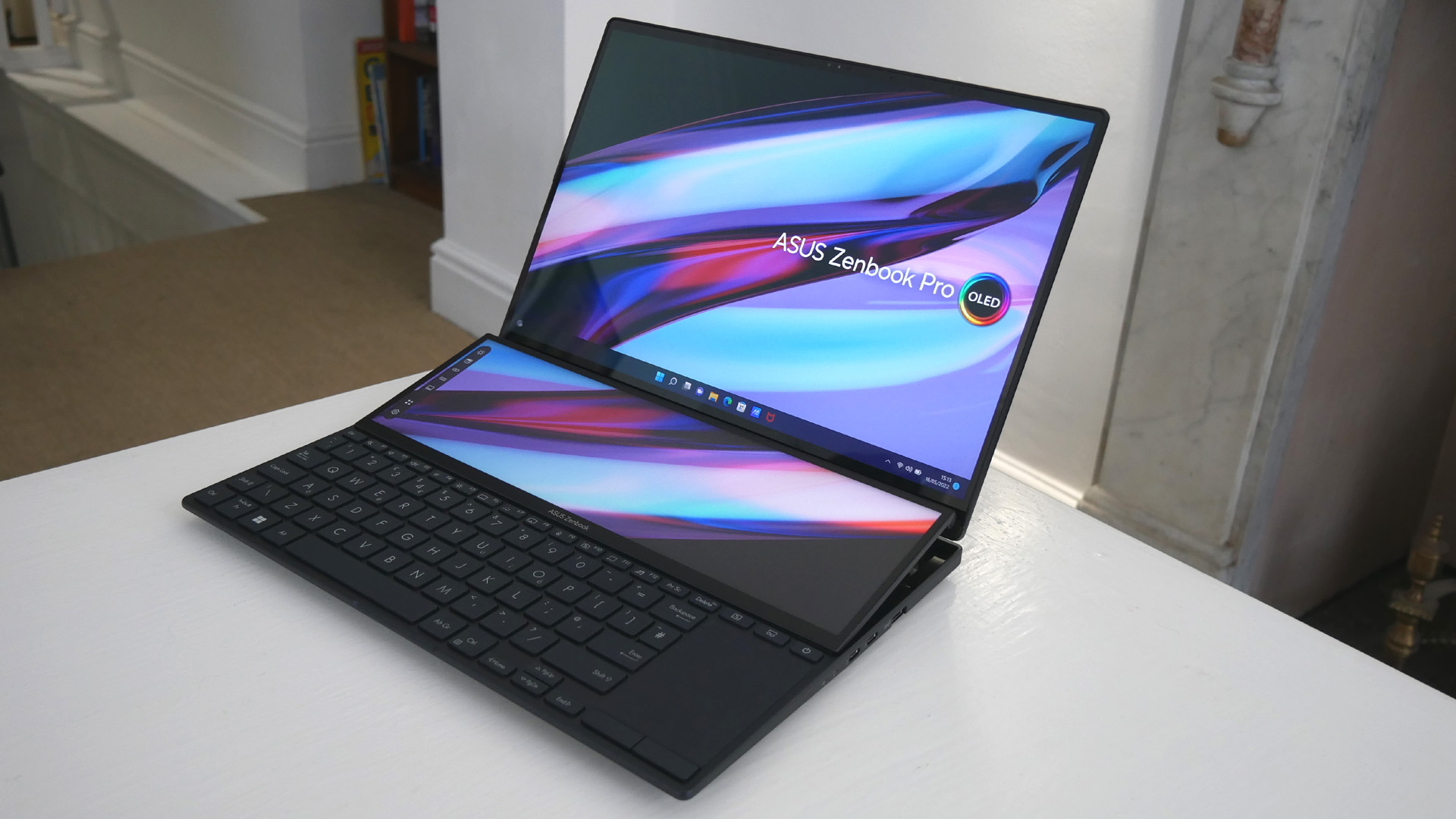
Ergonomics are a very personal thing, but there’s no denying the Asus Zenbook Pro 14 Duo OLED’s exotic dual-screen design does come at a cost in terms of usability. The unusual keyboard and trackpad ergonomics do take some getting used to. They are also absolutely not how you’d design a laptop were it not for the dual screens.
The usability compromises extend to poor battery life, which is unlikely to go much beyond five hours unless you are very careful, disable the second screen and don’t run any intensive apps. The relatively extreme packaging also limits performance slightly compared to larger laptops with similar components.
On the other hand, the Asus Zenbook Pro 14 Duo OLED has an awful lot going for it. It’s beautifully built. And if your workflows can benefit from the novel dual-screen design and inking support, it may well be worth the compromises. Moreover, despite the slight performance deficit compared to the very quickest laptops, this is still a hugely powerful portable PC. It’s a niche proposition, then, the Asus Zenbook Pro 14 Duo OLED. But if it ticks your particular boxes, there’s nothing else quite like it.
Read more: The best laptops for graphic design
out of 10
Stellar build quality, two gorgeous screens and some seriously powerful components. The Asus Zenbook Pro 14 Duo OLED has all of that and more. It’s a stupendous machine. The 120Hz OLED panel is a real highlight, but excellent connectivity and great sound quality only add to the appeal. On the downside, the dual-screen design makes for challenging keyboard and trackpad ergonomics, while the life is disappointing. It’s not for everyone, the Asus Zenbook Pro 14 Duo OLED. But for certain workflows, it’s a genuine delight.

Jeremy has been writing about technology since the 90nm Netburst era (Google it!) and enjoys nothing more than a serious dissertation on the finer points of input lag and overshoot followed by a forensic examination of advanced lithography. Or maybe he just loves machines that go 'ping!'. He has written for a variety of publications, including TechRadar, The Independent, Digital Camera World, T3, PC Gamer, GamesRadar+.
